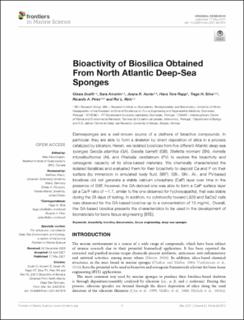| dc.contributor.author | Dudik, Olesia | |
| dc.contributor.author | Amorim, Sara | |
| dc.contributor.author | Xavier, Joana R. | |
| dc.contributor.author | Rapp, Hans Tore | |
| dc.contributor.author | Silva, Tiago H. | |
| dc.contributor.author | Pires, Ricardo A. | |
| dc.contributor.author | Reis, Rui L. | |
| dc.date.accessioned | 2022-03-31T13:51:34Z | |
| dc.date.available | 2022-03-31T13:51:34Z | |
| dc.date.created | 2022-01-25T13:01:09Z | |
| dc.date.issued | 2021-05-17 | |
| dc.identifier.issn | 2296-7745 | |
| dc.identifier.uri | https://hdl.handle.net/11250/2988933 | |
| dc.description.abstract | Demosponges are a well-known source of a plethora of bioactive compounds. In particular, they are able to form a skeleton by direct deposition of silica in a process catalyzed by silicatein. Herein, we isolated biosilicas from five different Atlantic deep-sea sponges Geodia atlantica (GA), Geodia barretti (GB), Stelletta normani (SN), Axinella infundibuliformis (AI), and Phakellia ventilabrum (PV) to explore the bioactivity and osteogenic capacity of its silica-based materials. We chemically characterized the isolated biosilicas and evaluated them for their bioactivity to deposit Ca and P on their surface (by immersion in simulated body fluid, SBF). GB-, SN-, AI-, and PV-based biosilicas did not generate a stable calcium phosphate (CaP) layer over time in the presence of SBF, however, the GA-derived one was able to form a CaP surface layer (at a Ca/P ratio of ∼1.7, similar to the one observed for hydroxyapatite), that was stable during the 28 days of testing. In addition, no cytotoxicity toward L929 and SaOs2 cells was observed for the GA-based biosilica up to a concentration of 10 mg/mL. Overall, the GA-based biosilica presents the characteristics to be used in the development of biomaterials for bone tissue engineering (BTE). | en_US |
| dc.language.iso | eng | en_US |
| dc.publisher | Frontiers | en_US |
| dc.rights | Navngivelse 4.0 Internasjonal | * |
| dc.rights.uri | http://creativecommons.org/licenses/by/4.0/deed.no | * |
| dc.title | Bioactivity of Biosilica Obtained From North Atlantic Deep-Sea Sponges | en_US |
| dc.type | Journal article | en_US |
| dc.type | Peer reviewed | en_US |
| dc.description.version | publishedVersion | en_US |
| dc.rights.holder | Copyright 2021 the authors | en_US |
| dc.source.articlenumber | 637810 | en_US |
| cristin.ispublished | true | |
| cristin.fulltext | original | |
| cristin.qualitycode | 1 | |
| dc.identifier.doi | 10.3389/fmars.2021.637810 | |
| dc.identifier.cristin | 1989479 | |
| dc.source.journal | Frontiers in Marine Science | en_US |
| dc.identifier.citation | Frontiers in Marine Science. 2021, 8, 637810. | en_US |
| dc.source.volume | 8 | en_US |

